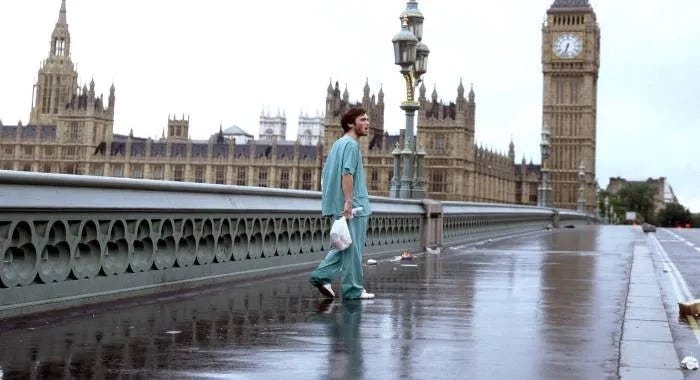28 Days Later (2002) – The Horror That Changed Everything
How Danny Boyle’s apocalyptic vision redefined the zombie genre and still haunts audiences today.
“This is what I’ve seen in the four weeks since infection: people killing people. Which is much what I saw in the four weeks before infection, and the four weeks before that, and before that. As far back as I care to remember—people killing people.” – Major West
A Dystopian Classic That Still Chills
Before 28 Days Later (2002), the zombie genre had grown somewhat stale. George A. Romero’s slow-moving, shambling undead had defined the horror landscape for decades, but Danny Boyle’s bold vision—and Alex Garland’s razor-sharp script—reinvented the apocalypse. Its depiction of humanity’s collapse in the wake of a “rage virus” still echoes today, proving that great horror isn’t just about monsters—it’s about us.
Movie Title: 28 Days Later
Genre: Horror, Thriller, Science Fiction
Director: Danny Boyle
Screenwriter: Alex Garland
Release Year: 2002
Lead Cast: Cillian Murphy, Naomie Harris, Brendan Gleeson, Megan Burns, Christopher Eccleston
Budget: ~$8 million
Notable Influence: Inspired Dawn of the Dead (2004), World War Z, The Walking Dead
A Haunting Premise Without Spoilers
The film follows Jim (Cillian Murphy), a messenger who wakes from a coma to an abandoned London. Gone are the crowds, the cars, the bustle—left behind is silence, suffocated by eerie emptiness. The terror doesn’t come from the infected alone. It’s in the isolation, the uncertainty, and, most chillingly, in the survivors still clinging to a world that no longer exists.
Jim, hard-edged survivalist Selena (Naomie Harris), and father-daughter pair Frank (Brendan Gleeson) and Hannah (Megan Burns) traverse a newly lawless Britain in search of refuge. Their journey leads them to a military installation promising safety—but as 28 Days Later so effectively demonstrates, the real monsters are often the ones still breathing.
A Visually and Aurally Unsettling Experience

Cinematography & Style
Shot with grainy Canon XL1 digital cameras, lending a rough, documentary-like immediacy.
London’s deserted streets were filmed at dawn before the city woke up, enhancing the authenticity of its eerie vacancy.
The jittery, handheld camerawork intensifies the chaos, making action sequences feel claustrophobic.
Sound Design & Score
John Murphy’s haunting track “In the House, In a Heartbeat” builds from a melancholic piano into an electrifying crescendo. It’s since been used extensively in trailers and action films, proof of its lasting influence.
Performances & Themes That Resonate
Cillian Murphy delivers a breakout performance—raw, unfiltered, and disturbingly believable.
Naomie Harris’ Selena is survival embodied, masking vulnerability under pragmatic ruthlessness.
Brendan Gleeson, as Frank, provides much-needed warmth, making his character’s fate all the more gut-wrenching.
Societal Decay & Survivalism
28 Days Later isn’t just a horror film. It’s a mirror reflecting the fragility of civilization. Major West’s authoritarian rule parallels real-world crisis responses, forcing us to question who truly holds power in desperate times.
Final Verdict: 4.5/5 Stars ⭐⭐⭐⭐½
28 Days Later isn’t a perfect film—its third act’s tonal shift from psychological horror to action thriller divides audiences, and its early digital cinematography looks dated on modern screens. But those perceived flaws contribute to its raw, immersive terror. Boyle’s handheld camerawork adds panic and intensity, and Murphy’s score is an unforgettable pulse that lingers long after the credits roll.
This is not merely a great horror film—it’s a landmark in modern dystopian cinema. A must-watch for fans of character-driven horror, apocalyptic thrillers, and films that disturb as much as they enthrall.
Where to Watch: Available on Apple TV, Amazon Prime Video, and JustWatch. Check streaming availability below.





